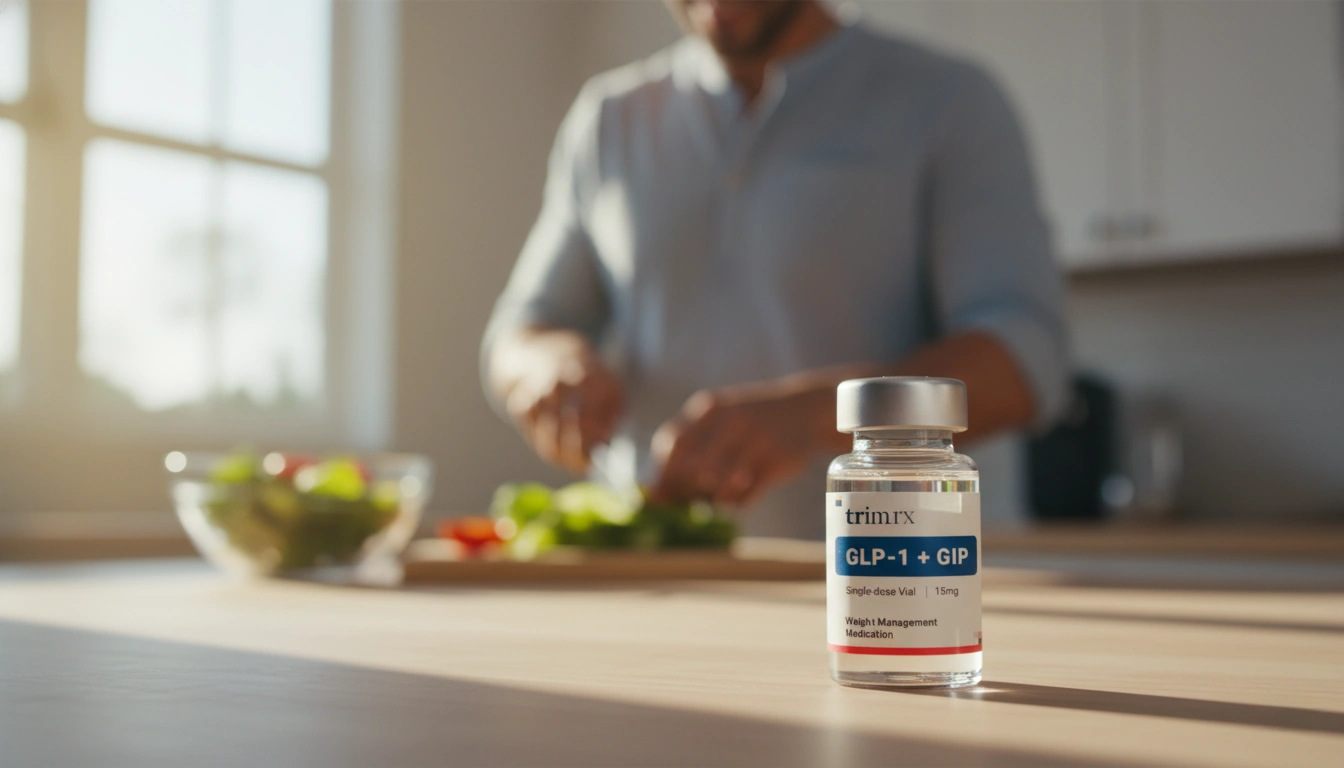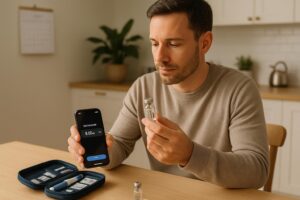What is Considered a Microdose of GLP-1?

Introduction
Did you know that nearly 70% of adults in the United States are classified as overweight or obese? This staggering statistic highlights the growing need for effective weight management solutions. GLP-1 receptor agonists have emerged as a game-changer in this field, offering significant weight loss results alongside improved metabolic health. However, as these medications have become more popular, so too has the idea of microdosing them.
Microdosing involves taking smaller doses of a medication than what is typically prescribed. This approach is appealing to many who wish to experience the benefits of GLP-1s while potentially avoiding the unpleasant side effects that can accompany higher doses. But what exactly constitutes a microdose of GLP-1, and how does it differ from standard dosing protocols?
In this blog post, we will delve into the definition of a microdose of GLP-1, the potential benefits, how to approach microdosing safely, and who it might be suitable for. We aim to provide you with a comprehensive understanding of this emerging trend, ensuring you feel informed and supported in your weight loss journey.
As we explore this topic, we will also highlight TrimRx’s commitment to personalized, medically supervised weight loss solutions, emphasizing our supportive approach to health and well-being. By the end of this article, you will have a clearer picture of what microdosing GLP-1 entails and whether it aligns with your weight loss aspirations.
In recent years, the conversation surrounding weight loss and metabolic health has taken a fascinating turn, especially with the rise of glucagon-like peptide-1 (GLP-1) receptor agonists. These medications, including popular names like Ozempic, Wegovy, Zepbound, and others, have gained attention for their effectiveness in weight management and diabetes control. But amongst this buzz, a new trend has emerged: microdosing GLP-1s. If you’ve ever wondered, “What is considered a microdose of GLP-1?” you’re not alone.
Microdosing, a term often associated with psychedelics, has now found its way into the realm of GLP-1 medications, suggesting that smaller, more flexible doses may provide benefits while minimizing side effects. At TrimRx, we believe in empowering individuals to understand their weight loss journeys fully, and today, we’ll explore the concept of microdosing GLP-1s, what it entails, and whether it might be a suitable option for you.
Understanding GLP-1 and Its Mechanism of Action
To grasp the concept of microdosing GLP-1, it’s essential first to understand what GLP-1 is and how it works in the body. GLP-1, or glucagon-like peptide-1, is a hormone produced in the intestines that plays a crucial role in regulating appetite, insulin secretion, and blood sugar levels. When we eat, GLP-1 is released, signaling to the brain that we are full and helping to manage glucose levels.
GLP-1 receptor agonists, such as Ozempic and Wegovy, mimic this natural hormone, offering a range of benefits, including:
- Appetite suppression: By enhancing feelings of fullness, GLP-1 medications can help reduce caloric intake.
- Improved blood sugar control: These medications help regulate blood sugar levels by stimulating insulin release and inhibiting glucagon secretion.
- Slower gastric emptying: This effect prolongs the sensation of fullness and reduces food intake.
For individuals struggling with obesity or type 2 diabetes, GLP-1 receptor agonists can lead to significant weight loss—often around 15% of body weight over several months when combined with lifestyle changes.
What is Microdosing GLP-1?
Microdosing GLP-1 refers to taking smaller doses of these medications than what is typically recommended by manufacturers or healthcare providers. For example, while a full dose of semaglutide (a common GLP-1 medication) may reach up to 2.4 mg, a microdose might be 0.25 mg, 0.5 mg, or even 1 mg, depending on individual needs and responses.
The concept stems from a desire to achieve the therapeutic benefits of GLP-1 while minimizing side effects. Common side effects of GLP-1 medications can include nausea, vomiting, and gastrointestinal discomfort, which can deter some individuals from continuing treatment. By microdosing, patients hope to find a balance that allows them to benefit from the medication without experiencing the full brunt of its side effects.
Key Considerations for Microdosing
While microdosing may seem like an appealing option, it’s vital to approach it thoughtfully. Here are some important considerations:
- Individual Variation: Each person’s response to medication can vary widely. What constitutes a microdose for one individual may be too low or too high for another. Personalized assessments are essential.
- Medical Supervision: We at TrimRx emphasize the importance of medical supervision when adjusting any medication dosage. It’s crucial to work with a healthcare provider who can guide you through the process safely.
- Gradual Titration: If considering microdosing, starting with the lowest possible dose and gradually increasing it based on tolerance and results is recommended. This approach allows for more personalized treatment and minimizes risks.
- Monitoring: Regular check-ins with your healthcare provider are essential to evaluate your progress, any side effects experienced, and to make necessary adjustments to your dosage.
- Potential Benefits: Microdosing may help individuals manage their weight and blood sugar levels while experiencing fewer side effects. However, it’s essential to be aware that research on microdosing GLP-1s is still emerging, and more studies are needed to understand its efficacy fully.
The Benefits of Microdosing GLP-1
Microdosing GLP-1 may provide several potential benefits, particularly for those who are sensitive to the side effects of standard doses. Here are some of the key advantages:
1. Reduced Side Effects
One of the most significant benefits of microdosing is the potential for reduced side effects. By taking lower doses, individuals may experience less nausea, vomiting, and gastrointestinal discomfort, making it easier to adhere to their treatment plan. This improvement in tolerability can lead to better long-term outcomes.
2. Personalized Treatment
Microdosing allows for a more tailored approach to medication. Individuals can work with healthcare providers to find the lowest effective dose that meets their needs, promoting a sense of empowerment in managing their health.
3. Cost-Effectiveness
Microdosing can be a more cost-effective approach to treatment. By utilizing smaller doses, individuals may extend the life of their medication, making it more affordable over time.
4. Flexibility in Dosing
Microdosing allows for flexibility in how the medication is administered. Some individuals may prefer to take smaller doses more frequently, which can help maintain steady blood levels of the medication and improve overall efficacy.
5. Enhanced Focus on Lifestyle Changes
By microdosing, individuals might find it easier to focus on implementing lifestyle changes that complement their treatment, such as adopting healthier eating habits and engaging in regular physical activity.
How to Approach Microdosing GLP-1 Safely
If you’re considering microdosing GLP-1 medications, it’s crucial to approach this method safely and responsibly. Here are steps to ensure a positive experience:
Step 1: Consultation with Healthcare Provider
Before making any changes to your medication regimen, consult with your healthcare provider. They can assess your individual situation, discuss your goals, and help determine if microdosing is appropriate for you.
Step 2: Start with the Lowest Dose
Begin with the lowest possible dose recommended by your provider. For semaglutide, this might be 0.25 mg. The goal is to minimize side effects while still achieving therapeutic benefits.
Step 3: Gradual Titration
After starting with a low dose, you may gradually increase the dosage based on your response and tolerance. Regular follow-ups with your provider are essential during this process to monitor your progress and make any necessary adjustments.
Step 4: Monitor Your Progress
Keep track of your weight loss journey, appetite, and any side effects you experience. Sharing this information with your healthcare provider will enable them to tailor your treatment effectively.
Step 5: Evaluate Regularly
Regular evaluations are crucial to ensure that microdosing is working for you. Your healthcare provider will help assess whether the current dosage is effective or if further adjustments are needed.
Who Might Consider Microdosing GLP-1?
Microdosing GLP-1 may be suitable for various individuals, particularly those who:
- Experience significant side effects from standard doses of GLP-1 medications.
- Prefer a more gradual approach to medication.
- Are looking to maintain their weight after achieving weight loss goals.
- Seek to improve blood sugar management without severe side effects.
However, those with specific medical conditions, such as severe gastrointestinal disorders or a history of pancreatitis, should avoid GLP-1 medications altogether. It’s essential to discuss your health history and medication options with your provider to determine the best course of action.
Conclusion
Microdosing GLP-1 receptor agonists presents a unique approach to weight management that may offer benefits while minimizing side effects. By starting with lower doses, individuals can potentially experience the therapeutic effects of these powerful medications without the discomfort often associated with higher doses.
At TrimRx, we are dedicated to providing personalized, medically supervised weight loss solutions that empower you in your health journey. Whether you’re considering microdosing or exploring other options, we encourage you to take our free assessment quiz to determine your eligibility for prescription weight loss medications. Together, we can navigate your path to achieving and maintaining a healthier weight.
FAQ
What is considered a microdose of GLP-1?
A microdose of GLP-1 typically involves taking a smaller dose than the standard prescription amount. For medications like semaglutide, a microdose may range from 0.25 mg to 1 mg, depending on individual needs and tolerability.
Can microdosing GLP-1 lead to weight loss?
Microdosing GLP-1 may help with weight management by suppressing appetite and improving blood sugar control, though individual results can vary. It is essential to monitor progress and adjust dosages as needed.
Is microdosing GLP-1 safe?
Microdosing can be safe when done under medical supervision. It’s crucial to consult with a healthcare provider before starting or adjusting any medication dosage.
How do I start microdosing GLP-1?
To start microdosing GLP-1, consult your healthcare provider, begin with the lowest possible dose, and gradually increase it based on your response. Regular follow-ups are essential to monitor progress.
What should I do if I experience side effects while microdosing?
If you experience side effects while microdosing GLP-1, contact your healthcare provider immediately. They can help assess your situation and make necessary adjustments to your dosage.
By understanding what microdosing GLP-1 entails and how it can fit into your weight loss journey, you can make informed decisions that align with your health goals. At TrimRx, we are here to support you every step of the way.

Transforming Lives, One Step at a Time
Keep reading
7 Tips for Sticking to GLP-1 Injection Schedules
Seven practical strategies to keep weekly GLP‑1 injections on schedule—pick a routine day, set reminders, manage side effects, rotate sites, and avoid missed doses.
Custom GLP-1 Dosing for Kidney Disease
Personalized GLP-1 dosing for CKD patients with monitoring, dehydration and hypoglycemia risk mitigation, and guidance across all kidney disease stages.
Semaglutide vs Tirzepatide: Approved Uses
Two leading diabetes and weight-loss drugs differ in FDA-approved benefits — one adds heart, kidney and liver protection; the other treats obstructive sleep apnea.



